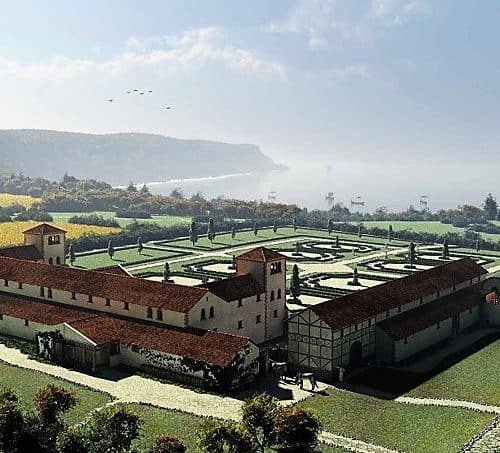Romans activity 1: a room with a view
The class investigate an exciting archaeological discovery on Folkestone’s East Cliff - which turns out to be Folkestone Roman Villa.
They look at evidence from the site, then create a 3D model, or artist’s impression of what they think a small part of it, such as the dining room (with its spectacular sea view), bath house or kitchen looked like, and how it was used in Roman times.
Image copyright: Smith Kriek Productions
Learning objectives
Increased knowledge and understanding of archaeology, Folkestone Roman Villa and an aspect of Roman life.
Research skills.
Art and design technology skills.
Curriculum links
KS1-2 History (Romans, Local History Study).
KS1-4 Art and design (artist’s impression of Folkestone Roman Villa)
KS1-4 Design technology (3D or CGI reconstruction of Folkestone Roman Villa)
Use the photos in Learn with Objects Romans 0: a pile of old stones on the interactive whiteboard.
Ask children the question What have archaeologists discovered on Folkestone’s East Cliff? Set them the challenge to find out more about this mystery building, and who lived in it in the past.
Pupils can explore the whole Learn with Objects Romans topic and excellent schools’ learning resources about this site on the Canterbury Archaeological Trust website.
http://www.canterburytrust.co.uk/learning/resources/ark_teacher_pack/
The link includes excellent cross-curricular ideas and information for teachers and pupils.
This has more detailed information about the site for teachers and older pupils:
The publication Folkestone to 1500: A Town Unearthed, edited by Ian Coulson, is also great background reading to the early history of Folkestone, including the Roman villa site. It’s also available from Canterbury Archaeological Trust.
http://www.canterburytrust.co.uk/publications/other-publications/folkestone-to-1500/
Having discovered more about the site, pupils are set a challenge to build a 3D model, or draw an artist’s impression, of what they think a small part of it (such as the dining room with its spectacular sea view), bath house or kitchen looked like, and how it was used in Roman times.
A room with a view
Working independently or in small teams, participants agree which room they are going to focus on. They research, discuss and agree content for the room based, where possible on real archaeological evidence from the site (including Folkestone Roman Villa room plans and relevant archaeological finds).
They should think about the following questions in coming to their final design:
- What shape is the room?
- How big is it?
- Is it a big room, designed to impress or a smaller one with a more practical use?
- Who owned the villa, the wealthy family , their guests, or slaves?
- Where are the windows and doors?
- Is there a view through the window of the sea, or the Downs, or an internal courtyard?
- How would the room have been decorated in Roman times?
- What was the floor like?
- What were the walls like?
- What furniture might there have been?
- Who would have used the room?
- What would they have worn?
- What would they have done in this room?
Think about the best viewpoint for the reconstruction, to show the layout of the room and the people using it, plus any views beyond.
Comparative evidence may also be used from similar rooms discovered at other Roman sites in Britain, or in the wider Roman world, such as at Pompeii.
The room can be created as a physical 3D cutaway model using everyday school art/craft materials, and painted and decorated to show Roman interior design and furniture. It might even include the underfloor heating system and construction of the tiled roof.
There are some great ideas of how to make one here.
http://downloads.bbc.co.uk/history/handsonhistory/romans_villas.pdf
Alternatively, it can be shown as an artist’s impression (either on paper as an art activity, or on computer).
Or it might be portrayed through computer modelling, perhaps as part of a KS3-4 design technology or computer science project, including a ‘walk through’ or rotation through 360 degrees.

